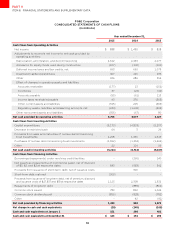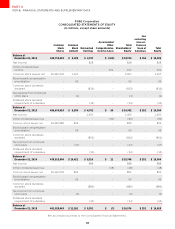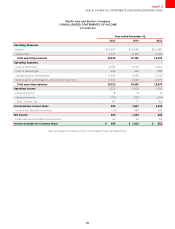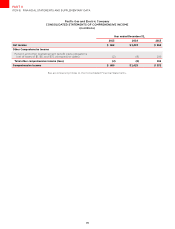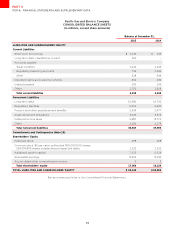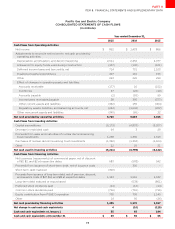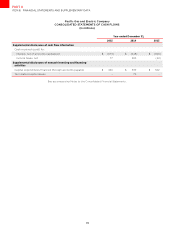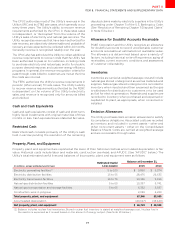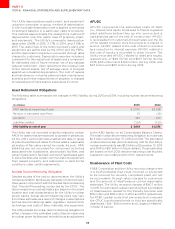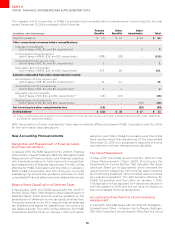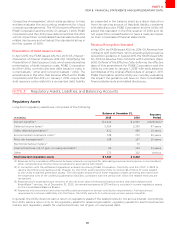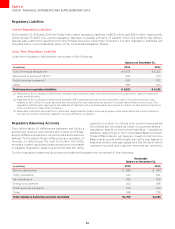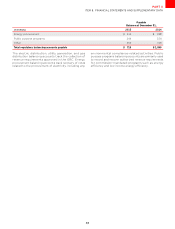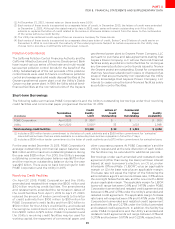PG&E 2015 Annual Report Download - page 84
Download and view the complete annual report
Please find page 84 of the 2015 PG&E annual report below. You can navigate through the pages in the report by either clicking on the pages listed below, or by using the keyword search tool below to find specific information within the annual report.
76
PART II
ITEM 8.FINANCIAL STATEMENTS AND SUPPLEMENTARY DATA
Notes to the Consolidated Financial Statements
NOTE 1: Organization and Basis of Presentation
PG&E Corporation is a holding company whose primary
operating subsidiary is Pacific Gas and Electric Company,
a public utility operating in northern and central California.
The Utility generates revenues mainly through the sale and
delivery of electricity and natural gas to customers. The
Utility is primarily regulated by the CPUC and the FERC.
In addition, the NRC oversees the licensing, construction,
operation, and decommissioning of the Utility’s nuclear
generation facilities.
This is a combined annual report of PG&E Corporation
and the Utility. PG&E Corporation’s consolidated financial
statements include the accounts of PG&E Corporation, the
Utility, and other wholly owned and controlled subsidiaries.
The Utility’s consolidated financial statements include
the accounts of the Utility and its wholly owned and
controlled subsidiaries. All intercompany transactions
have been eliminated in consolidation. The Notes to the
Consolidated Financial Statements apply to both PG&E
Corporation and the Utility. PG&E Corporation and the
Utility assess financial performance and allocate resources
on a consolidated basis (i.e., the companies operate in
one segment).
The accompanying consolidated financial statements
have been prepared in conformity with GAAP and in
accordance with the reporting requirements of Form 10-K.
The preparation of financial statements in conformity with
GAAP requires the use of estimates and assumptions that
aect the reported amounts of assets, liabilities, revenues
and expenses and the disclosure of contingent assets
and liabilities. Some of the more significant estimates and
assumptions relate to the Utility’s regulatory assets and
liabilities, legal and regulatory contingencies, environmental
remediation liabilities, AROs, and pension and other
postretirement benefit plans obligations. Management
believes that its estimates and assumptions reflected in
the consolidated financial statements are appropriate
and reasonable. Actual results could dier materially from
those estimates.
NOTE 2: Summary of Significant Accounting Policies
Regulation and Regulated Operations
The Utility follows accounting principles for rate-regulated
entities and collects rates from customers to recover “revenue
requirements” that have been authorized by the CPUC or
the FERC based on the Utility’s cost of providing service.
The Utility’s ability to recover a significant portion of its
authorized revenue requirements through rates is generally
independent, or “decoupled,” from the volume of the Utility’s
electricity and natural gas sales. The Utility records assets and
liabilities that result from the regulated ratemaking process
that would not be recorded under GAAP for nonregulated
entities. The Utility capitalizes and records, as regulatory
assets, costs that would otherwise be charged to expense
if it is probable that the incurred costs will be recovered
in future rates. Regulatory assets are amortized over the
future periods in which the costs are recovered. If costs
expected to be incurred in the future are currently being
recovered through rates, the Utility records those expected
future costs as regulatory liabilities. Amounts that are
probable of being credited or refunded to customers in the
future are also recorded as regulatory liabilities.
The Utility also records a regulatory balancing account
asset or liability for dierences between customer billings
and authorized revenue requirements that are probable
of recovery or refund. In addition, the Utility records a
regulatory balancing account asset or liability for dierences
between incurred costs and customer billings or authorized
revenue meant to recover those costs, to the extent that
these dierences are probable of recovery or refund. These
dierences have no impact on net income. (See “Revenue
Recognition” below.)
Management continues to believe the use of regulatory
accounting is applicable and that all regulatory assets and
liabilities are recoverable or refundable. To the extent that
portions of the Utility’s operations cease to be subject to
cost of service rate regulation, or recovery is no longer
probable as a result of changes in regulation or other
reasons, the related regulatory assets and liabilities are
written o.
Revenue Recognition
The Utility recognizes revenues when electricity and natural
gas services are delivered. The Utility records unbilled
revenues for the estimated amount of energy delivered
to customers but not yet billed at the end of the period.
Unbilled revenues are included in accounts receivable
on the Consolidated Balance Sheets. Rates charged to
customers are based on CPUC and FERC authorized
revenue requirements.


